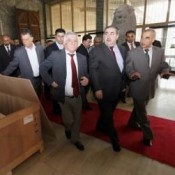Jean-Luc Martinez, the former Louvre Museum Director, was accused of turning a blind eye regarding the documentation of object provenance in the Louvre Abu Dhabi.
Jean-Luc Martinez, the Louvre Museum’s director from 2013 to 2021 was questioned for three days over compliance with the shady acquisition, in 2016 of a group of objects which were obtained to join the collection of the Louvre Abu Dhabi. In particular, the acquisition of a pink granite stela depicting Pharaoh Tutankhamun, as part of the group, was considered a success story for the Louvre Abu Dhabi, due to the object’s craftsmanship, its history and its very connection with the renowned “boy King”, whose tomb, discovered a century ago, is still considered a pivotal moment in the history of Egyptology. However, the stele’s dark track from Egypt to the Louvre Abu Dhabi might bring bad news for many experts involved in its selection and publication. These, apart from Martinez, include Head of the Louvre’s Egyptian antiquities department Vincent Rondot, and Egyptologist Olivier Perdu, both of which have been questioned but released.
The story starts for Martinez in 2016 when the Louvre Abu Dhabi bought the stele of Tutankhamun and four other works of art. Acquisitions of the Louvre Abu Dhabi must have been approved by a joint commission co-chaired by the Louvre director. So, it should have been Martinez who approved the acquisition of the Tutankhamun stela and the other objects, following their sale from Hamburg-based Germano-Lebanese dealer Roben Dib. For the record, Dib had been operating with historic Cairo antiquity dealers Simonian Brothers, but from 2009 he also supplied the auctions of Bergé & Associates dealer Christophe Kunicki.
Only a year later, in 2017, Kunicki, sold a gold gilded sarcophagus ascribed to Egyptian priest Nedjemankh to New York’s Metropolitan Museum of Art. Soon after, the sarcophagus’ provenance was questioned, with the investigation leading to documenting its illegal trafficking out of Egypt back in 2011, following the Arab Spring. Investigators also found that the sarcophagus had reached Kunicki through none else than Roben Dib, the Louvre Abu Dhabi dealer. In 2019, as the sarcophagus of Nedjemankh returned back to Egypt, Egyptologist Marc Gabolde was working on the publication of the Tutankamun stela which Dib had sold to the Louvre Abu Dhabi. According to the BBC, Gabolde’s queries over the provenance of the stele had remained unanswered by the Louvre.
Gabolde’s work was published in March 2020 by the Revue d’Égyptologie, the official journal of the French Egyptological Society, edited by Perdu. The same year, Christophe Kunicki was finally charged with criminal conspiracy, gang fraud, and laundering following his illegal sales to the MET. As his collaborator, Dib was approached, and alleged art trafficking but denied all accusations. At the same time, the headquarters of Agence France Muséums, the French agency for the Louvre Abu Dhabi, was raided by the French bureau against art trafficking (OCBC) seizing documents related to its activities, for investigation.
Still, it took two years for the authorities to be able to detain Roben Dib, who was finally charged with gang fraud and money laundering in March 2022. According to Le Monde, “the investigators suspect Kunicki and Dib of having produced false documents and invented false origins in order to “launder” hundreds of archaeological objects looted in different countries in the Near and Middle East”. In his turn, according to the Guardian, Martinez could have turned a blind eye to fake certificates of origin for pieces bought through Dib.
Time and further investigations will show the depth of Martinez’s responsibility for the acquisition and the end of the story. For the time being, and following his three-day questioning, Martinez was released under judicial control and is in Athens, to participate in a congress of the French newspaper «Le Figaro».





